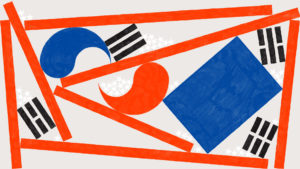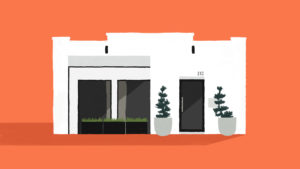
Making Long Distance (Creative) Relationships Work
Bora Kim worked as a designer at Athletics from 2016 to 2018, during which time she played a critical role in shaping the character of brands like Hubble, Music Together, and Williamsburg Northside School. In March of 2019 we parted ways when Bora returned to her home city of Seoul, South Korea. But like Vito Corleone in The Godfather Part III, just when she thought she was out, we pulled her back in. Bora’s visual wit, technical acuity, and effortless charm were such that we invited her to continue collaborating with Athletics remotely. Over a series of projects for clients including Samsung and Culdesac, we’ve structured a vibrant long-distance creative relationship with the talented young designer. Here Bora shares a few thoughts about her experience working with Athletics, and collaborating with our team from nearly 7,000 miles away.

I first came to New York to study graphic design at the School of Visual Arts. I eventually found work at Athletics, where I stayed for about three years after graduating. My favorite aspect of working at the studio was enjoying the company of a highly professional group of creatives. It felt like something special, and it was. Being new to the design industry, and not having grown up in the United States, it took some time for me to get used to the processes and practices of an American creative business. But Athletics—being an intimate studio of friendly people who looked out for me—was the perfect place to start my career and learn the ins and outs of the creative practice. Living so far from familiar faces, it was invaluable to have the support and care of my colleagues, whom I learned to lean on as I would my closest friends. New York can be isolating and overwhelming, so I can’t overstate the importance of having this “work family.”
Music Together was the first project I worked on at Athletics. Since the scope of the project was pretty broad—from brand identity development to animation—I could contribute to many aspects of the design, and learn plenty from each. Even though I was just an intern at the time, I had the opportunity to lead the development of motion graphics and illustrations. This was a challenge for me because I wasn’t confident about my motion and illustration skills at that point. Nevertheless, I polished my rusty skills and produced materials that formed foundation of the new Music Together brand. I think it’s those kinds of moments of uncertainty and doubt that galvanize designers to become their best selves.
Since moving back home to Seoul, the way in which I interact with the Athletics team has, naturally, changed significantly. The biggest challenge is not being able to work intimately with the studio. Video conferences have come so far, but it’s hard to replicate the power of spontaneous inspirational chitchats and spur-of-the-moment feedback sessions around computers. On the other hand, there have also been benefits to working remotely, particularly during our project with Samsung. Being located in Korea, I was able to research and observe first-hand my country’s technology market and gauge public reactions firsthand. Korea is one of the most fast-changing cultures in the world, absorbing, processing, and seeking out trends and technologies at a rate that might seem dizzying to other cultures.

In terms of the mechanics of our collaboration with Samsung, I was able to act as a “cultural bridge” between the Athletics team in New York and the Samsung team in Seoul. This involved aligning terms to make sure we were speaking the same language, as designers in Korea and the United States often use different terms to describe the same things, or the same terms but with different meanings. This points to a necessary step in any international collaboration, particularly those involving a language barrier: term alignment. One can never assume a client understands any specific term. And even if they do, it’s essential to confirm that both parties understand and use the term in the same way. Once vocabularies are aligned, the process of collaborating tends to be pretty universal, albeit with minor cultural differences, such as styles of delivering feedback. While American clients are often comfortable offering their opinions immediately after having work presented to them, Korean teams will rarely indicate their response until discussing internally as a team. This can be somewhat jarring for American teams presenting to Korean clients, but once you realize it’s part of the culture to seek consensus before providing feedback, you won’t mistake silence for displeasure or disappointment.
I’m grateful to be able to provide my cultural insight to help strengthen Athletics’ relationships abroad, and to have the opportunity to continue cultivating my relationship with the studio across continents, oceans, and time zones. I’ll end with a piece of advice for students entering the design field:
Don’t be afraid to try something new. It will keep you fresh.
All illustrations by Bora Kim